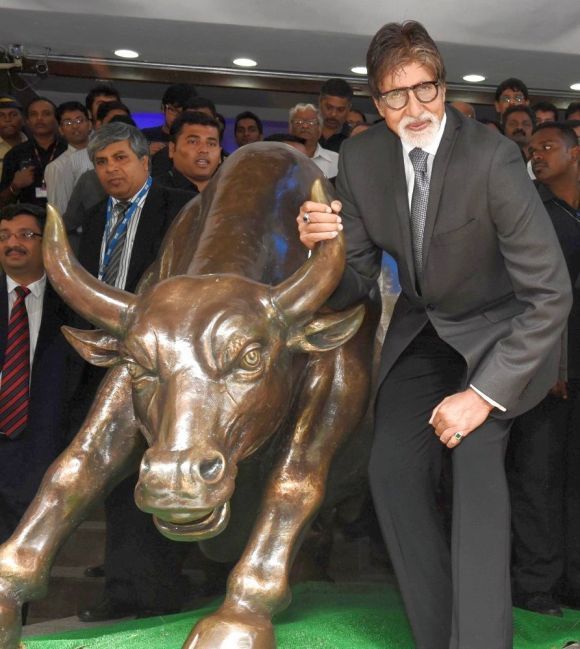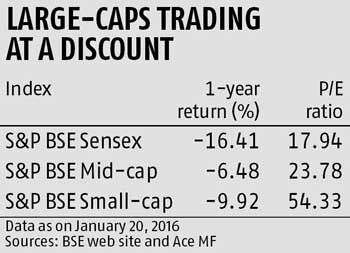 | « Back to article | Print this article |
Large-cap scrips are still trading at a discount to mid-caps. While this gap is expected to narrow, investors should take a stock-specific approach in the current market, explains Sanjay Kumar Singh.

Normally, mid-cap stocks rise faster than large-caps during a bull run and fall harder in a bear market. Mid-caps did outperform large-caps in the post-election rally.
However, they have remained more expensive than large-caps in the ensuing bear run, though the gap has narrowed in recent weeks (see table: Large-caps trading at a discount).
Should investors put their money in large-caps now, given their more attractive valuations?
Why have mid-caps outperformed?
The earnings growth of many mid-cap companies has been far better than in several large-cap names.
Mid-cap companies in India also tend to be exposed more to the domestic market, while many large-cap ones derive a considerable part of their revenue from global markets.
Examples are Tata Motors, Tata Steel, Hindalco and Bharti Airtel. Says Taher Badshah, co-head of equities, Motilal Oswal AMC: "Since growth-related challenges have been higher in the global markets, Nifty companies have grown at a weaker pace than mid-caps."
In the latter part of 2015, foreign institutional investors (FIIs) were continuously paring their exposure to emerging market exchange-traded funds (ETFs).
India gets a large part of its foreign inflows by virtue of being a part of these ETFs. Though FIIs were selling primarily to avoid exposure to countries affected by the commodity slump, such as Brazil, Russia and China, Indian stocks also got sold, being part of the ETF basket.
ETFs tend to have greater exposure to large-cap stocks. Domestic institutional investors (DIIs) like mutual funds (MFs), on the other hand, have been investing heavily in the equity market.
They have been willing to take exposure wherever they see higher earning prospects, including mid-caps. Says Sachin Shah, fund manager and head, Emkay PMS: "A lot of the inflows that MFs received were in their mid- and small-cap funds, so their mandate led them to invest in these stocks. The impact cost in this space also tends to be higher."
Currently, the performance gap over the one-year horizon between the Sensex and the BSE Mid-cap Index is about 10 percentage points.
"From a pure valuation standpoint, large-caps as a basket do look more attractive than mid-caps. At the index level, you might see some convergence in performance and valuation over the next six to 12 months in favour of large-caps," says Badshah.
However, experts emphasise that not all large-caps will outperform and all mid-caps underperform. Hence, investors need to take a stock-specific and bottom-up approach.
With the markets correcting steeply, experts see value emerging across the board.
"Financials, pharmaceuticals, oil and gas - today, there is value across the market," says Gopal Agrawal, chief investment officer at Mirae Asset Global Investments (India).
In his view, businesses that cater to urban consumers are a great buy. In the infrastructure space, he suggests betting on segments that could benefit from a rise in government spending (owing to the massive saving on the oil import bill and revenue gains from the increase in excise duty).
Those that will benefit from reduction in power transmission and distribution losses are also a good bet, says Agrawal.
Shah suggests investing in private sector banks and non-bank finance companies, automobiles and select power utilities in the large-cap space.
In the mid-cap segment, he likes companies in the defence, leisure holidays and water sectors, and those that will benefit from opportunities in the railways sector. He emphasises the need to be selective in the mid-cap space.
 What should you avoid?
What should you avoid?
Due to global deflationary pressures, some sectors of the market are under pressure, such as metals and minerals, and the banks that have lent to these. Avoid these.
After the recent correction, investors should not buy a stock only because its price has become attractive.
"Go with companies where there has been a price correction but whose earnings visibility has not been affected significantly. Check the underlying fundamentals and look for sustainability of growth," says Badshah.
Investors should also avoid getting into richly-valued stocks. In the past few years, valuations have got polarised.
The market has rewarded some sectors and stocks highly, as they continued to perform even during the downturn. A recent report from Antique Stock Broking warns that a tipping point might have been reached.
Any bad news or earnings disappointments could result in a sharp fall in such stocks, as the recent examples of Nestle, Dr Reddy's and Motherson Sumi demonstrate. Finally, don't exit in panic.
"With the fall, more opportunities will emerge. Avoid buying at one go and instead spread out your investments," says Shrey Jain, founder, SAS Online, a Delhi-based discount broking entity.